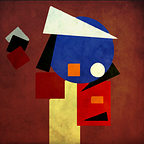Vadim Georgievich Meller
Vadim Georgievich Meller (1884–1962) was a Russian and Ukrainian avant-garde artist, suprematist, cubo-futurist and constructivist.
He studied painting at the Munich Academy of Arts and in Paris in the studio of Antoine Bourdelle. For many years worked as a theater artist in Kiev and Kharkov theaters. Taught at the Kiev Academy of Art together with V. Tatlin and A. Bogomazov.
At the university, Meller met a fellow student, the future star of modernism, Paul Klee. During this time he also met Vasily Kandinsky, with whom he became friends.
Vadim Meller then moved to Paris, where he lived from 1912 to 1914. Together with other Russian artists such as Kazimir Malevich, Sonia Delaunay, Alexander Archipenko and Alexandra Exter, Meller exhibited in the Spring and Autumn Salons alongside artists such as Pablo Picasso, Georges Braque and André Derain. In 1921–1922 Vadim Meller worked as an artist at the Kiev Shevchenko Opera and Ballet Theater. In 1922 Meller he was invited by Alexander Kurbas to the post of chief artist in the Ukrainian theater “Berezil”. In 1925 Vadim Meller, together with Sonia Delaunay, Alexandra Exter, and Nathan Altman, participated in the International Exhibition of Decorative Arts and Art Industry (Art Deco) in Paris, where his work for the Berezil Theater was awarded a gold medal, leaving silver to Alexander Rodchenko for his design of the Workers’ Club. In the same year, Vadim Meller’s work was exhibited at the International Exhibition of Theater Art in New York. In 1925 Meller taught at the Kiev Academy of Art for a while, along with Vladimir Tatlin and Alexander Bogomazov. In 1926, together with the Berezil Theater troupe, Meller moved to Kharkov. He joined the Association of Revolutionary Artists of Ukraine founded by David Burlyuk. Later he participated in the decoration of the city for the revolutionary holidays in Russia.
In 1924–1925, Meller’s main creative pursuits were connected to film art, where he worked as a film artist. Also during this period he is engaged in illustrating books.
In 1927, with Alexander Kurbas, he traveled to Germany (to the theater exhibition in Hanover) and to Prague. In 1928, together with Lisitzky, Alexander Tyshler and Vasily Yermilov, he took part in the design of the Soviet pavilion at the International Press Exhibition in Cologne.
In 1934 Vadim Meller worked on the decoration of the Kharkov District House of the Red Army named after K.E. Voroshilov (greatest Soviet general). The building stood for 9 years and was destroyed during the World War 2 in 1943. In 1935 he participated in the design of the Kharkov Palace of Pioneers. His switch to scenography as his main field of artistic activity occurred in the post-revolutionary years. He worked as a constructivist, suprematist and cubo-futurist. He worked as a constructivist and cubo-futurist. Vadim Meller, since the 1920s, has participated in numerous collective exhibitions in Moscow, Kiev, Kharkov, New York, etc. His only solo exhibition was held in Kiev in 2004 (posthumously).
Some of Vadim Meller’s works are kept in the National Art Museum of Ukraine in Kiev, Russian, Canadian and American museums.
Meller’s paintings are full of deep inner logic, a fine sense of rhythm, and the integrity of the composition, which is organically linked to the space.
Meller suffered from Nazi’s during WW2 as much as he did from Soviet Government, he lost many friends during purges. Some of them were arrested, some of them sentenced to death. One of his closest friend Alexander Kurbas — Ukrainian and Soviet actor, theatrical and film director — was arrested in Moscow in 1933 in the case of the “Ukrainian Military Organization”. In April 1934, he was sentenced to 5 years by the judicial troika of the Collegium of the GPU of the Ukrainian SSR. In 1937 he was sentenced to the highest punishment by the Special Troika of the Department of Internal Affairs. He was executed on November 3, 1937 in Karelia. Rehabilitated in 1957. He was a good friend of Vadim Meller, with whom he worked together in the theater and other projects. After the political persecution behind Alexander Kurbas, Meller suffered from this as well. He was subjected to many interrogations and searches at his home, caught up in the wave of repression that was going on in those years in the USSR. At the end of his life, he and his wife taught art to children in local art schools. Vadim Georgievich Meller died on May 4, 1962, in Kiev in poverty as well as most of suprematist and avant-garde artists in Soviet Union. He is buried in the Baikove cemetery.
